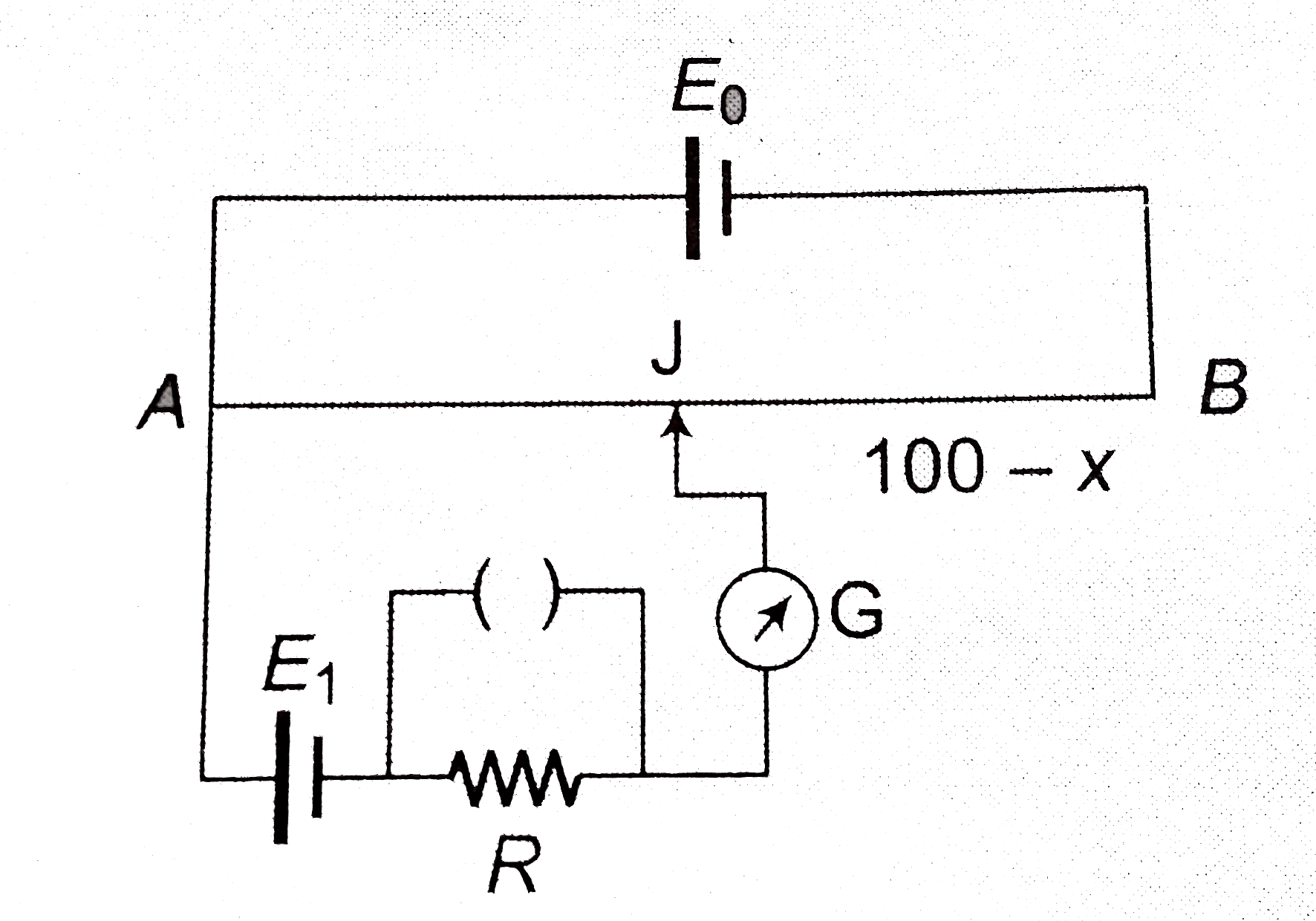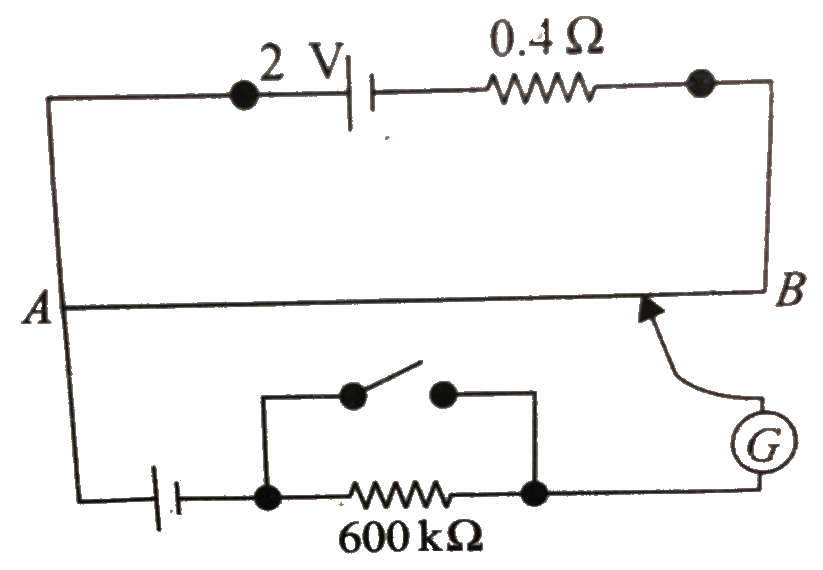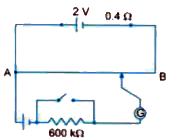
The figure shows a potentiometer using a cell E of emf 2.0V and internal resistance 0.40Ω connected to a resistor wire AB. A standard cell of constant emf of 1.02V gives a balance point a t 67.3cm length of the wire. A very high resistance R=100kΩ is put in with the standard cell. This resistance is shorted by inserting switch S when close to the balance point. The standard cell is then replaced by a cell of unknown emf E and the null point turns out to be 82.3cm length of the wire.
(a) What is the value of E ?
(b) What is the purpose of using the high resistance R ?
( c) Is the null point affected by this high resistance ?
(d) Is the null point affected by the internal resistance of the cell E ?
( e) Would this method work if
(i) the internal resistance of cell E were higher than the resistance of wire AB and
(ii) the emf of cell E were 1.0V instead of 2.0V ?
(a) E=1.0267.3×82.3=1.25V
(b) The high resistance R keeps the current from standard cell within permissible limit and prevent a large current to flow through the galvanometer when far away from the balance point.
( c) Al null point, no current flow through R, hence no effect no null point.
(d) The null point depends on terminal voltage of E0 and the emf of E only, hence no effect.
( e) If p.d across AB due to the driver cell E0 become less than the emf of cell E1, method will fail, there would be no null point on the wire AB
(i) p.d across AB due to cell E0 of emf 2V will be less than 1V. Since emf of the standard cell is greater than this value, no null point on AB
(ii) No null point on AB.
Topper's Solved these Questions
Similar Questions
Figure 6.36 shows a potentiometer with a cell of emf 2.0V and internal resistance 0.4Ω maintaining a potential drop across the resistor wire AB. A standard cell that maintains a constant emf of 1.02V (for very moderate current up to emf μA) gives a balance point at 67.3cm length of the wire. To ensure very low current is drawn the standard cell, a very high resistance of 600kΩ is put in series with it, which is shorted close to the balance point. The standard cell is then replaced by a cell of unknown emf ε and the balance point found, similary, turns out to be at 82.3cm length of the wire.
a. What is the value of ε?
b.What purpose does the high resistance of 600kΩ have?
c. Is the balance point affected by this high resistance?
d. Is the balance point affected by internal resistance of the driver cell?
e. Would the method work in the above situation if the driver cell of the potentiometer had an emf of 1.0V instead of 2.0V?
f. Would the circuit work well for determining an extermely small emf, say of the order of a few mV (such as the typical emf of a thermocouple)? If not, how will you modify the circuit ?

View Solution
Fig. shows a potentiometer with a cell of 2.0 V and internal resistance 0.40 Ω maintaining a potential drop across the resistor wire AB. A standard cell which maintains a constant emf of 1.02 V (for very moderate currents up to a few mA) gives a balance point at 67.3 cm length of the wire. To ensure very low currents drawn from the standard cell, a very high resistance of 600 kΩ is put in series with it, which is shorted close to the balance point. The standard cell is then replaced by a cell of unknown emf and the balance point found similarly, turns out to be at 82.3 cm length of the wire.
(a) What is the value of ε ? (b) What purpose does the high resistance of 600 kΩ have ? (c) Is the balance point affected by this high resistance ? (d) Would the method work in the above situation if the driver cell of the potentiometer had an emf of 1.0 V instead of 2.0 V? (e) Would the circuit work well for determining an extremely small emf, say of the order of a few mV (such as the typical emf of a thermo-couple) ? If not, how will you modify the circuit ?
View Solution
Knowledge Check
A cell of emf 2.0 V and internal resistance 0.1 Ω is connected with a resistance of 3.9Ω. The voltage across the cell terminals will be
A0.50 VB1.90 VC1.95 VD2.0 VA cell of emf 2 V and internal resistance 0.1Ω is connected with a resistance of 3.9Ω The voltage across the cell terminal will be
A1.95VB1.90VC0.50VD2.00V
A cell of emf 1.1V and internal resistance 0.5Ω is connected to a wire of resistance 0.5Ω. Another cell of the same emf is connected in series bur the current in the wire remain the same .Find the internal resistance of second cell
View SolutionIn a potentiometer circuit, the emf of driver cell is 2V and internal resistance is 0.5Ω. The potentiometer wire is 1m long . It is found that a cell of emf 1V and internal resistance 0.5Ω is balanced against 60 cm length of the wire. Calculate the resistance of potentiometer wire.
View SolutionA potentiometer wire of length 1.0 m has a resistance of 10Ω. It is connected to a 6 V battery in seried with a resistance of 5Ω. Determine the emf of the primary cell which gives a balance point at 40 cm.
View SolutionA potentiometer wire of length 1 m has a resistance of 10Ω. It is connected to a 6V battery in series with a resistance of 5Ω. Determine the emf of the primary cell which gives a balance point at 40cm.
View SolutionA potentiometer wire of length 1.0 m has a resistance of 15 ohm. It is connected to a 5 V source in series with a resistance of 5Ω. Determine the emf of the primary cell which has a balance point at 60 cm.
View SolutionA potentiometer wire of length 1 m has a resistance of 5Ω. It is connected to a 8 V battery in series with a resistance of 15Ω. Determine the emf of the primary cell which gives a balance point at 60 cm.
View Solution